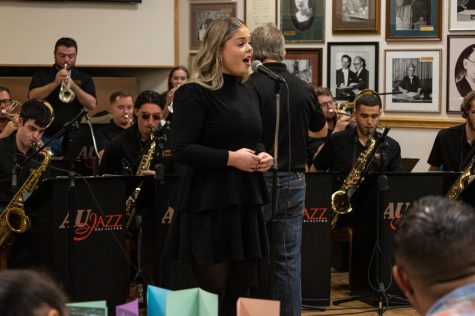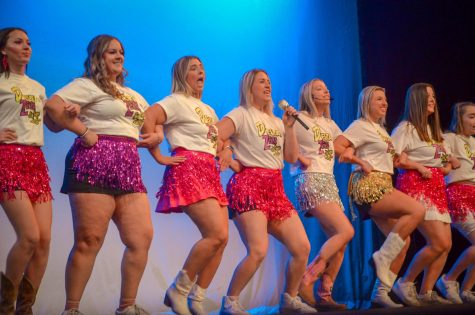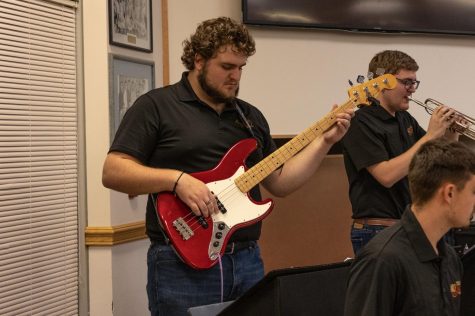‘Sunday in the Park With George’: a puzzling yet pleasing musical
March 3, 2011
Upon walking into the Studio Theater to watch “Sunday in the Park With George,” I was prepared. Armed with the knowledge that this musical could be confusing, I readied myself for any twists or turns that might happen.
Turns out, the warning about the complexity was much appreciated, because I did find myself scrambling to piece together events as they sporadically happened-there were times when I was confused. By the end, however, I was able to make sense of the events and derive meaning from it.
The musical opens up with Georges Seurat painting his girlfriend, Dot, while she grudgingly models for him in the park. The opening number, “Sunday in the Park With George,” wastes no time in letting the audience know that Dot and Georges’s relationship is in a delicate state, teetering more towards the side of romantic disaster.
Madeline Beer, who plays Dot, sings this song with plenty of emotion; just from Beer’s tone and facial expressions, one gets the sense that Dot is a sassy, bold woman. Much to the audience’s delight, Dot’s unique character adds life to the play as well as humor. As for Beer, her vocals are simply radiant.
It would be a well-justified statement to say she clearly has one of the strongest voices in the entire production. As the play goes on, Beer continues to perform just as well as her opening number, delivering every line with impressive range as well as projection.
The audience does not get to hear the voice of Jake Kinney, who plays Georges, until a few songs into the musical as he sings “Color and Light” with Beer. Kinney is able to carry the weight of his role with relative ease, clearly portraying Georges as a pensive, moody man. He does this not only through the many nuances in his voice, but in his nonverbal gestures as well.
In addition to such assets, Kinney makes a quite convincing Georges Seurat, beard and all. A well-deserved kudos goes out to the hair and makeup crew, if not for Kinney’s transformation to a nineteenth-century painter, then for the intricate details that were put forth with the rest of the cast.
The first half of the musical primarily focuses on the process Georges goes through to create his masterpiece, “A Sunday on La Grande Jatte.” Georges has a very scientific thought process and strives to alter the impressionistic technique by using distinct brush strokes, essentially dots, much to the disapproval of his critics. Meanwhile, as he painstakingly toils away on his work, his relationship with his girlfriend continues to deteriorate.
The end of act one concludes with chaos rippling throughout the park where Georges is painting: couples are squabbling, fights are breaking out and children are screaming. All of a sudden, Georges commands the town folk to attention, as if he has a magic power over them, and restores a sense of peace and harmony within the park.
…Reverting back to my initial point, that’s where I became slightly confused. Again, it wasn’t until the musical came to an end that the dense fog of confusion began to lift.
Act two opens up with the characters who had been perusing the park in the previous scene. Only, instead of being able to move around, they are literally trapped in Georges’s painting. This is certainly not meant to horrify the audience-instead, the musical number “It’s Hot Up Here,” proves to be very funny.
In this fast-paced song, the characters all take turns complaining about the discomfort in wherever they stand. A mother, for example, grumbles about her daughter squeezing her hand too tightly, while another person laments not being in the shade on such a sweltering day.
Following this song is a rapid transition to the future to about a century later. The lead male is still played by Kinney and his name is George, the supposed great-grandson of Georges Seurat. Like his great-grandfather, George is an artist who toys with conventional art styles and constantly struggles to gain the critics’ approval.
There is a moment at the end in which George, discouraged by the success of his art show, considers abandoning his passion. Unexpectedly, Dot appears (which could be interpreted as a vision or dream) and essentially gives George his confidence back. At this point Dot and George sing “Move On,” perhaps one of the stronger numbers in the musical. It concludes with George gaining the resolve to continue on with his work, once more inspired.
One of the unique facets of the play is that it presents information without any explanation whatsoever, such as how George might be able to communicate with his deceased great-grandmother.
It is both frustrating yet refreshing; on one hand, audience members are left to interpret events arbitrarily, while on the other, audience members may grow weary of the disjointed nature of the play.
From my interpretation, scenes such as the one at the end of the first act when Georges inexplicably turns his real-life environment into order represent life through an artist’s eyes.
Georges’s work is about establishing harmony and balance, which is portrayed through his ability to grab a hold of chaos and control it.
There is mayhem taking place all around Georges as he paints, yet he is able to construct his painting-based off of the chaotic park he so frequently visits- to ultimately represent a sense of symmetry in the world.
Aside from Beer and Kinney, there were of course many other talented actors and actresses who helped make “Sunday in the Park With George” the overall success that it was. While the plot itself could have easily dragged on-after all, it is a two-and-a-half hour musical primarily about the notion of an artist defying the critics and creating work as he desires-the cast is talented and passionate enough to deliver every line with convincing sincerity.
“Sunday in the Park With George” is certainly a complex musical that has potential to be quite moving if you open up your mind and allow it to be.









